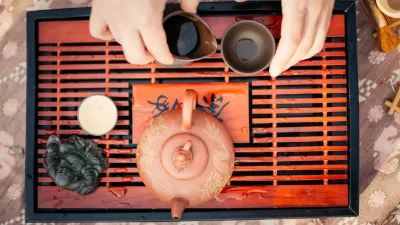Japaneese Tea Ceremony
Travelling always presents the opportunity to immerse oneself in diverse cultures, customs and traditions. One such illustrious tradition that Japan offers its visitors is the Japanese Tea Ceremony, or 'Chado.' Also known as the Way of Tea, this ritual holds immense significance in Japanese society and presents an intricate blend of aesthetics, culture, and philosophy.
Overview of the Japanese Tea Ceremony
The Japanese tea ceremony is a meticulously choreographed process of preparing and serving green tea, known as 'Matcha.' What makes this event particularly intriguing is how it transcends the act of merely brewing and drinking tea. Furthermore, it is an embodiment of a unique philosophy that seeks to express appreciation for life's simple joys, embrace serenity, and foster a sense of harmony with nature and others.
This ancient tradition dates back to the 9th century when Buddhist monks introduced tea to Japan from China. Over time, it has evolved to become an integral part of Japanese heritage and a symbol of the country's sophisticated and profound aesthetics—an experience that should be high on every traveller's list when visiting Japan.
Elements of the Japanese Tea Ceremony
An authentic tea ceremony is a distinct blend of multiple elements—ranging from the design and layout of the tea room, the selection of utensils, to the sequence of events—that all serve to create a tranquil environment and envelop guests in an atmosphere of tranquillity and mindful presence.
The tea room, known as 'Chashitsu,' is often a small, discrete space within a house or a stand-alone structure within a traditional Japanese garden. The decor is minimalistic and typically comprised of natural materials that embody Wabi-Sabi, an ancient Japanese philosophy that celebrates the beauty in imperfection.
Entering the tea house is often through a low door called 'Nijiriguchi,' which serves to symbolize equality and humility: a manifestation of the core philosophy behind the tea ceremony. Visitors leave their worldly status and distractions outside, stooping down to enter the room as equals, no matter their social status.
The atmosphere is further enhanced through the use of selective tea utensils or 'Chadogu.' These traditionally include a tea bowl ('Chawan'), a bamboo whisk ('Chasen'), a tea scoop ('Chashaku'), and a tea caddy ('Natsume'). Each of these utensils is chosen with great care for its aesthetic appeal and the season, and they are handled with deep reverence by the host.
The Ceremony Process
A typical Japanese tea ceremony unfolds over several stages, each executed with precision and deliberate slowness that encourages mindfulness. The host meticulously cleans each utensil before preparing the tea, movements carefully choreographed and graceful, similar to a serene dance. Each step is significant and demands the undivided attention—not just of the host but also the guests—turning the event into a meditative process that fosters peace and harmony.
The ceremony begins with the guests admiring the tea utensils and the calligraphy scroll in the alcove ('Tokonoma'), often chosen specifically for the ceremony. Then, the host serves traditional Japanese sweets ('Wagashi') to offset the bitter taste of the Matcha tea. Following this, the host begins preparing the tea, and each guest in turn is served a bowl of Matcha. As the bowl is received, a bow is given in gratitude. The recipient rotates the bowl (to avoid drinking from its front), takes a sip, compliments the host on the tea, wipes the rim, rotates the bowl back to its original position, and passes it to the next guest.
The Significance of the Japanese Tea Ceremony
The beauty of the tea ceremony lies not just in the meticulous preparation of the tea but also in the underlying values that it promotes. The guiding principles are 'Wa,' 'Kei,' 'Sei,' and 'Jaku,' translating to harmony, respect, purity, and tranquility. Essentially, the tea ceremony encapsulates a way of life—fostering grace, gratitude, and mindfulness.
Exploring Japan's tea ceremony gives travellers the opportunity to connect with the country's rich history and culture on a deeper level, simultaneously offering a unique memory to take home. Whether participating in a tea ceremony in Kyoto—the heart of Japanese tea culture—or in any other city, the experience enables travellers to truly appreciate the deliberate and elegant simplicity, the zen-like tranquility, and the deep-rooted customs that define this beautiful culture. It serves as a gentle reminder that in our fast-paced, modern world, taking a moment to slow down, focus, and appreciate the smaller details in life can often bring deep joy and inner peace.
Cultural Tapestry: Unforgettable Experiences with Diverse Traditions and Cultures

